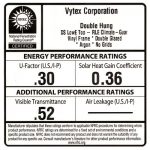How to Read an NFRC Sticker on Energy-Efficient Replacement Windows
All ENERGY STAR®

Qualified energy-efficient replacement windows must be tested by an independent lab to determine the products’ performance ratings. The National Fenestration Rating Council (NFRC), an unbiased government-authorized entity, reviews these ratings, which provide the basis for ENERGY STAR® window performance requirements and helps consumers compare the performance of various window brands and types. Look for low U-factor and Summer Solar Heat Gain Coefficient (SHGC) numbers for highest efficiency performance.
Winter U-factor
The lower a replacement window’s overall U-value, the less heat you will lose through that window. A lower U-value means you’ll use less energy to heat your home in the winter.
Summer Solar Heat Gain Coefficient
A lower SHGC means less solar radiation is admitted through your window. Your home will remain cooler in the summer and your air conditioner will not have to work as hard.
Visible Transmittance
Visible Transmittance (VT) measures how much light comes through a product. The higher the visible transmittance, the clearer the piece of glass.
Air Leakage
Lower numbers mean fewer drafts and less air infiltration. The lowest number the government assigns is a .1; windows with an air leakage number above .3 fail this test.
Condensation Resistance (CR)
The higher the CR rating, the better the product is at resisting condensation formation on the interior surface of the product. While this rating cannot predict condensation, it provides a method of comparing the potential of various products for condensation formation.
Contact a Vytex dealer now for more information on the right energy-efficient replacement windows for your home.






